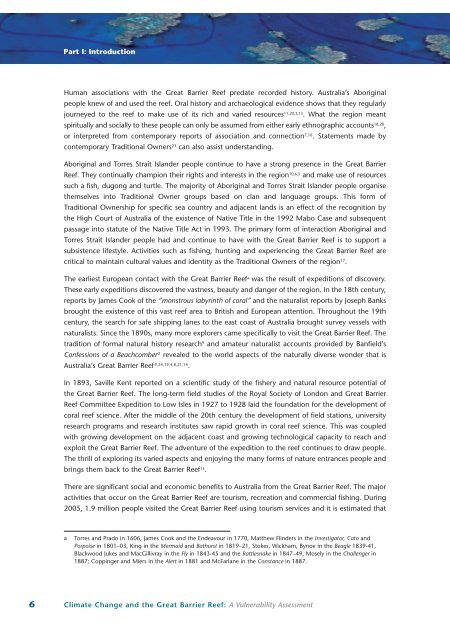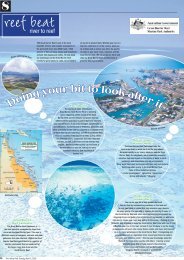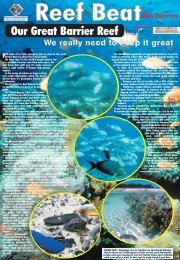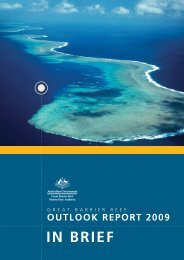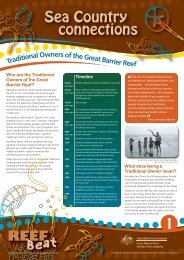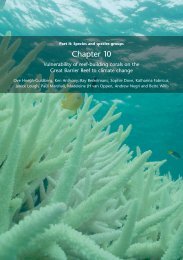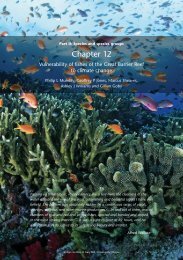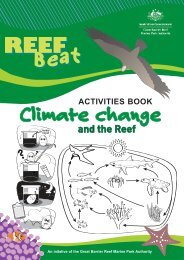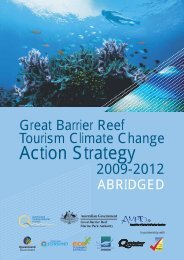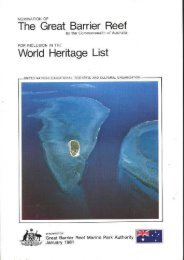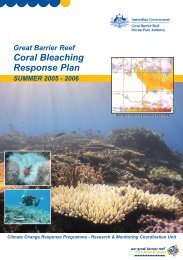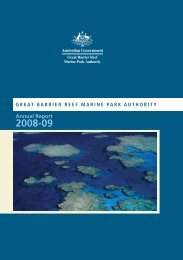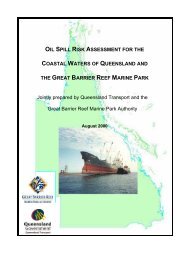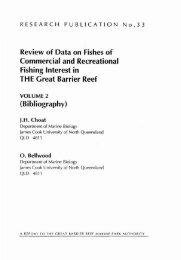Chapter 1: Introduction to the Great Barrier Reef and climate change
Chapter 1: Introduction to the Great Barrier Reef and climate change
Chapter 1: Introduction to the Great Barrier Reef and climate change
Create successful ePaper yourself
Turn your PDF publications into a flip-book with our unique Google optimized e-Paper software.
Part I: <strong>Introduction</strong><br />
Human associations with <strong>the</strong> <strong>Great</strong> <strong>Barrier</strong> <strong>Reef</strong> predate recorded his<strong>to</strong>ry. Australia’s Aboriginal<br />
people knew of <strong>and</strong> used <strong>the</strong> reef. Oral his<strong>to</strong>ry <strong>and</strong> archaeological evidence shows that <strong>the</strong>y regularly<br />
journeyed <strong>to</strong> <strong>the</strong> reef <strong>to</strong> make use of its rich <strong>and</strong> varied resources 11,20,3,13 . What <strong>the</strong> region meant<br />
spiritually <strong>and</strong> socially <strong>to</strong> <strong>the</strong>se people can only be assumed from ei<strong>the</strong>r early ethnographic accounts 18,20 ,<br />
or interpreted from contemporary reports of association <strong>and</strong> connection 7,16 . Statements made by<br />
contemporary Traditional Owners 23 can also assist underst<strong>and</strong>ing.<br />
Aboriginal <strong>and</strong> Torres Strait Isl<strong>and</strong>er people continue <strong>to</strong> have a strong presence in <strong>the</strong> <strong>Great</strong> <strong>Barrier</strong><br />
<strong>Reef</strong>. They continually champion <strong>the</strong>ir rights <strong>and</strong> interests in <strong>the</strong> region 10,6,5 <strong>and</strong> make use of resources<br />
such a fish, dugong <strong>and</strong> turtle. The majority of Aboriginal <strong>and</strong> Torres Strait Isl<strong>and</strong>er people organise<br />
<strong>the</strong>mselves in<strong>to</strong> Traditional Owner groups based on clan <strong>and</strong> language groups. This form of<br />
Traditional Ownership for specific sea country <strong>and</strong> adjacent l<strong>and</strong>s is an effect of <strong>the</strong> recognition by<br />
<strong>the</strong> High Court of Australia of <strong>the</strong> existence of Native Title in <strong>the</strong> 1992 Mabo Case <strong>and</strong> subsequent<br />
passage in<strong>to</strong> statute of <strong>the</strong> Native Title Act in 1993. The primary form of interaction Aboriginal <strong>and</strong><br />
Torres Strait Isl<strong>and</strong>er people had <strong>and</strong> continue <strong>to</strong> have with <strong>the</strong> <strong>Great</strong> <strong>Barrier</strong> <strong>Reef</strong> is <strong>to</strong> support a<br />
subsistence lifestyle. Activities such as fishing, hunting <strong>and</strong> experiencing <strong>the</strong> <strong>Great</strong> <strong>Barrier</strong> <strong>Reef</strong> are<br />
critical <strong>to</strong> maintain cultural values <strong>and</strong> identity as <strong>the</strong> Traditional Owners of <strong>the</strong> region 17 .<br />
The earliest European contact with <strong>the</strong> <strong>Great</strong> <strong>Barrier</strong> <strong>Reef</strong> was <strong>the</strong> result of expeditions of discovery.<br />
These early expeditions discovered <strong>the</strong> vastness, beauty <strong>and</strong> danger of <strong>the</strong> region. In <strong>the</strong> 18th century,<br />
reports by James Cook of <strong>the</strong> “monstrous labyrinth of coral” <strong>and</strong> <strong>the</strong> naturalist reports by Joseph Banks<br />
brought <strong>the</strong> existence of this vast reef area <strong>to</strong> British <strong>and</strong> European attention. Throughout <strong>the</strong> 19th<br />
century, <strong>the</strong> search for safe shipping lanes <strong>to</strong> <strong>the</strong> east coast of Australia brought survey vessels with<br />
naturalists. Since <strong>the</strong> 1890s, many more explorers came specifically <strong>to</strong> visit <strong>the</strong> <strong>Great</strong> <strong>Barrier</strong> <strong>Reef</strong>. The<br />
tradition of formal natural his<strong>to</strong>ry research 9 <strong>and</strong> amateur naturalist accounts provided by Banfield’s<br />
Confessions of a Beachcomber 2 revealed <strong>to</strong> <strong>the</strong> world aspects of <strong>the</strong> naturally diverse wonder that is<br />
Australia’s <strong>Great</strong> <strong>Barrier</strong> <strong>Reef</strong> 9,24,19,4,8,21,14 .<br />
In 1893, Saville Kent reported on a scientific study of <strong>the</strong> fishery <strong>and</strong> natural resource potential of<br />
<strong>the</strong> <strong>Great</strong> <strong>Barrier</strong> <strong>Reef</strong>. The long-term field studies of <strong>the</strong> Royal Society of London <strong>and</strong> <strong>Great</strong> <strong>Barrier</strong><br />
<strong>Reef</strong> Committee Expedition <strong>to</strong> Low Isles in 1927 <strong>to</strong> 1928 laid <strong>the</strong> foundation for <strong>the</strong> development of<br />
coral reef science. After <strong>the</strong> middle of <strong>the</strong> 20th century <strong>the</strong> development of field stations, university<br />
research programs <strong>and</strong> research institutes saw rapid growth in coral reef science. This was coupled<br />
with growing development on <strong>the</strong> adjacent coast <strong>and</strong> growing technological capacity <strong>to</strong> reach <strong>and</strong><br />
exploit <strong>the</strong> <strong>Great</strong> <strong>Barrier</strong> <strong>Reef</strong>. The adventure of <strong>the</strong> expedition <strong>to</strong> <strong>the</strong> reef continues <strong>to</strong> draw people.<br />
The thrill of exploring its varied aspects <strong>and</strong> enjoying <strong>the</strong> many forms of nature entrances people <strong>and</strong><br />
brings <strong>the</strong>m back <strong>to</strong> <strong>the</strong> <strong>Great</strong> <strong>Barrier</strong> <strong>Reef</strong> 15 .<br />
There are significant social <strong>and</strong> economic benefits <strong>to</strong> Australia from <strong>the</strong> <strong>Great</strong> <strong>Barrier</strong> <strong>Reef</strong>. The major<br />
activities that occur on <strong>the</strong> <strong>Great</strong> <strong>Barrier</strong> <strong>Reef</strong> are <strong>to</strong>urism, recreation <strong>and</strong> commercial fishing. During<br />
2005, 1.9 million people visited <strong>the</strong> <strong>Great</strong> <strong>Barrier</strong> <strong>Reef</strong> using <strong>to</strong>urism services <strong>and</strong> it is estimated that<br />
<br />
Torres <strong>and</strong> Prado in 1606, James Cook <strong>and</strong> <strong>the</strong> Endeavour in 1770, Mat<strong>the</strong>w Flinders in <strong>the</strong> Investiga<strong>to</strong>r, Ca<strong>to</strong> <strong>and</strong><br />
Porpoise in 1801–03, King in <strong>the</strong> Mermaid <strong>and</strong> Bathurst in 1819–21, S<strong>to</strong>kes, Wickham, Bynoe in <strong>the</strong> Beagle 1839-41,<br />
Blackwood Jukes <strong>and</strong> MacGillivray in <strong>the</strong> Fly in 1843-45 <strong>and</strong> <strong>the</strong> Rattlesnake in 1847–49, Mosely in <strong>the</strong> Challenger in<br />
1887; Coppinger <strong>and</strong> Miers in <strong>the</strong> Alert in 1881 <strong>and</strong> McFarlane in <strong>the</strong> Constance in 1887.<br />
<br />
Climate Change <strong>and</strong> <strong>the</strong> <strong>Great</strong> <strong>Barrier</strong> <strong>Reef</strong>: A Vulnerability Assessment


